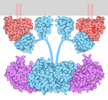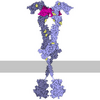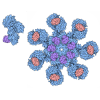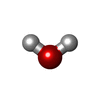[English] 日本語
 Yorodumi
Yorodumi- PDB-1sg1: Crystal Structure of the Receptor-Ligand Complex between Nerve Gr... -
+ Open data
Open data
- Basic information
Basic information
| Entry | Database: PDB / ID: 1sg1 | ||||||
|---|---|---|---|---|---|---|---|
| Title | Crystal Structure of the Receptor-Ligand Complex between Nerve Growth Factor and the Common Neurotrophin Receptor p75 | ||||||
 Components Components |
| ||||||
 Keywords Keywords | HORMONE/GROWTH FACTOR/MEMBRANE PROTEIN / Nerve Growth Factor / NGF / p75 / Neurotrophin / common neurotrophin receptor / growth factor receptor / receptor-ligand complex / HORMONE-GROWTH FACTOR-MEMBRANE PROTEIN COMPLEX | ||||||
| Function / homology |  Function and homology information Function and homology informationRegulated proteolysis of p75NTR / NFG and proNGF binds to p75NTR / NADE modulates death signalling / Axonal growth inhibition (RHOA activation) / Axonal growth stimulation / NFG and proNGF binds to p75NTR / NRIF signals cell death from the nucleus / NF-kB is activated and signals survival / death receptor activity / detection of temperature stimulus ...Regulated proteolysis of p75NTR / NFG and proNGF binds to p75NTR / NADE modulates death signalling / Axonal growth inhibition (RHOA activation) / Axonal growth stimulation / NFG and proNGF binds to p75NTR / NRIF signals cell death from the nucleus / NF-kB is activated and signals survival / death receptor activity / detection of temperature stimulus / dorsal aorta development / p75NTR recruits signalling complexes / Ceramide signalling / nerve growth factor receptor binding / positive regulation of odontogenesis of dentin-containing tooth / preprotein binding / negative regulation of hair follicle development / NGF processing / positive regulation of synaptic transmission, cholinergic / positive regulation of neuron maturation / TRKA activation by NGF / negative regulation of fibroblast growth factor receptor signaling pathway / PLC-gamma1 signalling / Signalling to STAT3 / negative regulation of blood vessel endothelial cell proliferation involved in sprouting angiogenesis / neurotrophin binding / negative regulation of dendritic spine development / metalloendopeptidase inhibitor activity / p75NTR negatively regulates cell cycle via SC1 / nerve growth factor signaling pathway / nerve growth factor binding / nerve development / Retrograde neurotrophin signalling / clathrin-coated endocytic vesicle / Axonal growth stimulation / NADE modulates death signalling / regulation of neurotransmitter secretion / positive regulation of collateral sprouting / positive regulation of myelination / peripheral nervous system development / Signalling to p38 via RIT and RIN / neurotrophin TRKA receptor binding / transmembrane receptor protein tyrosine kinase activator activity / ARMS-mediated activation / positive regulation of neural precursor cell proliferation / regulation of release of sequestered calcium ion into cytosol / axon extension / positive regulation of Ras protein signal transduction / PI3K/AKT activation / negative regulation of mitochondrial depolarization / regulation of reactive oxygen species metabolic process / hair follicle morphogenesis / neuronal cell body membrane / Frs2-mediated activation / NRAGE signals death through JNK / skin development / neurotrophin TRK receptor signaling pathway / positive regulation of Rho protein signal transduction / intracellular glucose homeostasis / odontogenesis of dentin-containing tooth / skeletal muscle cell differentiation / positive regulation of endothelial cell apoptotic process / extrinsic apoptotic signaling pathway via death domain receptors / fibroblast growth factor receptor signaling pathway / hair follicle development / positive regulation of excitatory postsynaptic potential / Signalling to RAS / positive regulation of synaptic transmission, glutamatergic / positive regulation of axon extension / coreceptor activity / Rho protein signal transduction / neuron projection morphogenesis / extrinsic apoptotic signaling pathway / extrinsic apoptotic signaling pathway in absence of ligand / dendrite membrane / positive regulation of neuron differentiation / sensory perception of pain / presynaptic modulation of chemical synaptic transmission / p75NTR recruits signalling complexes / axon guidance / NF-kB is activated and signals survival / cell surface receptor protein tyrosine kinase signaling pathway / NRIF signals cell death from the nucleus / negative regulation of cell migration / negative regulation of angiogenesis / central nervous system development / positive regulation of protein ubiquitination / endosome lumen / positive regulation of apoptotic signaling pathway / growth factor activity / neuromuscular junction / intracellular protein transport / circadian regulation of gene expression / positive regulation of neuron projection development / circadian rhythm / modulation of chemical synaptic transmission / positive regulation of miRNA transcription / positive regulation of protein localization to nucleus / Golgi lumen / small GTPase binding Similarity search - Function | ||||||
| Biological species |  Homo sapiens (human) Homo sapiens (human) | ||||||
| Method |  X-RAY DIFFRACTION / X-RAY DIFFRACTION /  SYNCHROTRON / SYNCHROTRON /  MIR / Resolution: 2.4 Å MIR / Resolution: 2.4 Å | ||||||
 Authors Authors | He, X.L. / Garcia, K.C. | ||||||
 Citation Citation |  Journal: Science / Year: 2004 Journal: Science / Year: 2004Title: Structure of nerve growth factor complexed with the shared neurotrophin receptor p75 Authors: He, X.L. / Garcia, K.C. | ||||||
| History |
|
- Structure visualization
Structure visualization
| Structure viewer | Molecule:  Molmil Molmil Jmol/JSmol Jmol/JSmol |
|---|
- Downloads & links
Downloads & links
- Download
Download
| PDBx/mmCIF format |  1sg1.cif.gz 1sg1.cif.gz | 92.2 KB | Display |  PDBx/mmCIF format PDBx/mmCIF format |
|---|---|---|---|---|
| PDB format |  pdb1sg1.ent.gz pdb1sg1.ent.gz | 69.4 KB | Display |  PDB format PDB format |
| PDBx/mmJSON format |  1sg1.json.gz 1sg1.json.gz | Tree view |  PDBx/mmJSON format PDBx/mmJSON format | |
| Others |  Other downloads Other downloads |
-Validation report
| Summary document |  1sg1_validation.pdf.gz 1sg1_validation.pdf.gz | 446.8 KB | Display |  wwPDB validaton report wwPDB validaton report |
|---|---|---|---|---|
| Full document |  1sg1_full_validation.pdf.gz 1sg1_full_validation.pdf.gz | 462.2 KB | Display | |
| Data in XML |  1sg1_validation.xml.gz 1sg1_validation.xml.gz | 21.8 KB | Display | |
| Data in CIF |  1sg1_validation.cif.gz 1sg1_validation.cif.gz | 31.3 KB | Display | |
| Arichive directory |  https://data.pdbj.org/pub/pdb/validation_reports/sg/1sg1 https://data.pdbj.org/pub/pdb/validation_reports/sg/1sg1 ftp://data.pdbj.org/pub/pdb/validation_reports/sg/1sg1 ftp://data.pdbj.org/pub/pdb/validation_reports/sg/1sg1 | HTTPS FTP |
-Related structure data
| Related structure data | 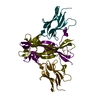 1wwwS S: Starting model for refinement |
|---|---|
| Similar structure data |
- Links
Links
- Assembly
Assembly
| Deposited unit | 
| ||||||||
|---|---|---|---|---|---|---|---|---|---|
| 1 |
| ||||||||
| Unit cell |
|
- Components
Components
| #1: Protein | Mass: 13515.410 Da / Num. of mol.: 2 Source method: isolated from a genetically manipulated source Source: (gene. exp.)  Homo sapiens (human) / Gene: NGFB / Production host: Homo sapiens (human) / Gene: NGFB / Production host:  #2: Protein | | Mass: 17258.014 Da / Num. of mol.: 1 Source method: isolated from a genetically manipulated source Source: (gene. exp.)   unidentified baculovirus / Strain (production host): Tn5 / References: UniProt: P07174 unidentified baculovirus / Strain (production host): Tn5 / References: UniProt: P07174#3: Chemical | ChemComp-CL / | #4: Water | ChemComp-HOH / | Has protein modification | Y | |
|---|
-Experimental details
-Experiment
| Experiment | Method:  X-RAY DIFFRACTION / Number of used crystals: 1 X-RAY DIFFRACTION / Number of used crystals: 1 |
|---|
- Sample preparation
Sample preparation
| Crystal | Density Matthews: 2.71 Å3/Da / Density % sol: 54.3 % |
|---|---|
| Crystal grow | Temperature: 295 K / Method: vapor diffusion, sitting drop / pH: 6.3 Details: PEG 1000, isoproponal, sodium chloride, citrate, pH 6.3, VAPOR DIFFUSION, SITTING DROP, temperature 295K |
-Data collection
| Diffraction | Mean temperature: 100 K |
|---|---|
| Diffraction source | Source:  SYNCHROTRON / Site: SYNCHROTRON / Site:  ALS ALS  / Beamline: 8.2.1 / Wavelength: 1.0597 Å / Beamline: 8.2.1 / Wavelength: 1.0597 Å |
| Detector | Type: ADSC QUANTUM 4 / Detector: CCD / Date: Oct 5, 2003 / Details: null |
| Radiation | Monochromator: null / Protocol: SINGLE WAVELENGTH / Monochromatic (M) / Laue (L): M / Scattering type: x-ray |
| Radiation wavelength | Wavelength: 1.0597 Å / Relative weight: 1 |
| Reflection | Resolution: 2.4→50 Å / Num. all: 16891 / Num. obs: 16891 / % possible obs: 99 % / Observed criterion σ(F): 0 / Observed criterion σ(I): 0 / Redundancy: 4.8 % / Biso Wilson estimate: 45 Å2 / Rmerge(I) obs: 0.083 / Net I/σ(I): 9.2 |
| Reflection shell | Resolution: 2.4→2.5 Å / Redundancy: 4.7 % / Rmerge(I) obs: 0.349 / Mean I/σ(I) obs: 2.4 / % possible all: 97.3 |
- Processing
Processing
| Software |
| |||||||||||||||||||||||||
|---|---|---|---|---|---|---|---|---|---|---|---|---|---|---|---|---|---|---|---|---|---|---|---|---|---|---|
| Refinement | Method to determine structure:  MIR MIRStarting model: part of the structure starts from PDB ENTRY 1WWW Resolution: 2.4→50 Å / Isotropic thermal model: Isotropic / Cross valid method: THROUGHOUT / σ(F): 0 / Stereochemistry target values: Engh & Huber
| |||||||||||||||||||||||||
| Displacement parameters | Biso mean: 50.4 Å2 | |||||||||||||||||||||||||
| Refinement step | Cycle: LAST / Resolution: 2.4→50 Å
| |||||||||||||||||||||||||
| Refine LS restraints |
| |||||||||||||||||||||||||
| LS refinement shell | Resolution: 2.4→2.49 Å
|
 Movie
Movie Controller
Controller





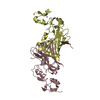
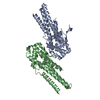


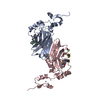
 PDBj
PDBj
